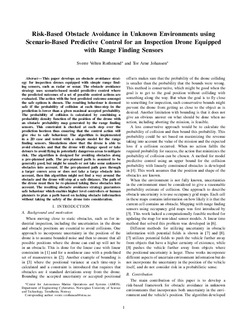| dc.contributor.author | Rothmund, Sverre Velten | |
| dc.contributor.author | Johansen, Tor Arne | |
| dc.date.accessioned | 2019-10-04T11:09:55Z | |
| dc.date.available | 2019-10-04T11:09:55Z | |
| dc.date.created | 2019-10-01T11:24:12Z | |
| dc.date.issued | 2019 | |
| dc.identifier.isbn | 978-1-7281-0333-4 | |
| dc.identifier.uri | http://hdl.handle.net/11250/2620304 | |
| dc.description.abstract | This paper develops an obstacle avoidance strategy for inspection drones equipped with simple range finding sensors, such as radar or sonar. The obstacle avoidance strategy uses scenario-based model predictive control where the predicted outcomes of a set of possible control actions are evaluated. The action with the best predicted outcome amongst the safe options is chosen. The resulting behaviour is deemed safe if the probability of collision at each time-step in the prediction is lower than a given maximal accepted probability. The probability of collision is calculated by combining a probability density function of the position of the drone with an obstacle probability map generated by the range finding sensors. This constraint is checked at each step over the prediction horizon thus ensuring that the control action will give rise to safe behaviour. The algorithm is implemented in a 2D case and tested with a simple model for the range finding sensors. Simulations show that the drone is able to avoid obstacles and that the drone will change speed or take detours to avoid flying in potentially dangerous areas to mitigate risk. The algorithm is designed for avoiding obstacles along a pre-planned path. The pre-planned path is assumed to be generally good, but might be unsafe or not take some unknown obstacles into account. If the pre-planned path goes through a larger convex area or does not take a large obstacle into account, then this algorithm might not find a way around the obstacle and the drone will stop at a safe distance. The path of the drone must then be re-planned taking these obstacles into account. The resulting obstacle avoidance strategy guarantees safe behaviour which enables higher level controllers or human planners to plan a path based on lacking obstacle information without taking the safety of the drone into consideration. | nb_NO |
| dc.language.iso | eng | nb_NO |
| dc.publisher | Institute of Electrical and Electronics Engineers (IEEE) | nb_NO |
| dc.relation.ispartof | 2019 International Conference on Unmanned Aircraft Systems (ICUAS) | |
| dc.title | Risk-Based Obstacle Avoidance in Unknown Environments using Scenario-Based Predictive Control for an Inspection Drone Equipped with Range Finding Sensors | nb_NO |
| dc.type | Chapter | nb_NO |
| dc.description.version | acceptedVersion | nb_NO |
| dc.identifier.doi | 10.1109/ICUAS.2019.8797803 | |
| dc.identifier.cristin | 1732263 | |
| dc.relation.project | Norges forskningsråd: 223254 | nb_NO |
| dc.relation.project | Norges forskningsråd: 274441 | nb_NO |
| dc.description.localcode | © 2019 IEEE. Personal use of this material is permitted. Permission from IEEE must be obtained for all other uses, in any current or future media, including reprinting/republishing this material for advertising or promotional purposes, creating new collective works, for resale or redistribution to servers or lists, or reuse of any copyrighted component of this work in other works. | nb_NO |
| cristin.unitcode | 194,63,25,0 | |
| cristin.unitname | Institutt for teknisk kybernetikk | |
| cristin.ispublished | true | |
| cristin.fulltext | postprint | |
| cristin.qualitycode | 1 | |
